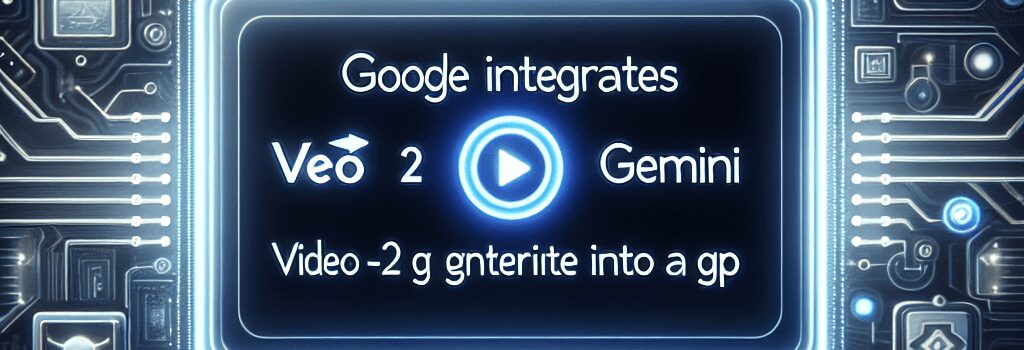Google Integrates Veo 2 Video Generator into Gemini App

Google has expanded the capabilities of its Gemini platform by rolling out the Veo 2 video generator—a state-of-the-art AI-driven tool that goes beyond traditional chatbots. Initially available to Gemini Advanced subscribers, this new feature enables users to generate short video clips by simply providing a descriptive text prompt. The rollout, which begins today, signals Google’s continued commitment to integrating cutting-edge AI models that engage both creative professionals and everyday users.
Unveiling Veo 2: Features and User Experience
At its core, Veo 2 operates similarly to other popular video generators in the market, such as OpenAI’s Sora. To produce an animated sequence, the user inputs a detailed text prompt. The input is transmitted to a Google data center where advanced algorithms process the text token-by-token, transforming it into a visual narrative. For instance, a prompt like “Aerial shot of a grassy cliff onto a sandy beach where waves crash against the shore, a prominent sea stack rises from the ocean near the beach, bathed in the warm, golden light of either sunrise or sunset,” results in a meticulously animated clip that reflects the serene beauty of such a coastal scene.
In the Gemini app, Veo 2 is available via a model drop-down menu, although Google is still exploring how best to integrate this feature for optimum user experience. Early adopters should note that while the technology is impressive, there is an inherent delay in reaching all paying customers—similar to previous rollouts like Gemini Live video—which took nearly a month to fully deploy across the subscriber base.
Technical Specifications and Performance
Veo 2 is engineered to deliver 8-second video clips in 720p format, with the final output downloadable as standard MP4 files. Under the hood, this system leverages massive parallel processing capabilities within Google’s data centers. The AI model demonstrates an adept understanding of real-world physics, especially in replicating human movements and natural phenomena. Nonetheless, early tests reveal that while many generated examples are visually appealing, the model occasionally struggles with complex physical interactions. For example, a test where a Martian moon was expected to collide with a monolith resulted in an anomaly where the moon only bypassed the structure before vanishing.
Due to the intensive computational processing required, Google has enforced a monthly usage cap. Although the exact limit remains unspecified, users receive notifications as they approach their quota. Additionally, the integration of Veo 2 in Whisk, a Google Labs experiment that facilitates image generation through both text prompts and sample images, provides an early playground for enthusiasts. The new “animate” option in Whisk allows still images to be dynamically transformed into 8-second video clips, with a stated limit of 100 videos per month, hinting at a similar restriction within the Gemini platform.
Expert Opinions and Future Directions
Industry experts highlight the importance of such generative AI tools in democratizing creative content generation. The capability to produce animations based solely on textual descriptions opens vast opportunities in advertising, educational media, and entertainment. However, experts also note that Veo 2’s simulation of physical dynamics—such as collision impacts and fluid movement—still has room for improvement. “While Veo 2 shows significant promise in blending AI with creative video editing, its occasionally erratic handling of physical interactions indicates that further refinement in the training models is necessary,” commented an AI researcher familiar with generative networks.
Looking ahead, Google appears committed to iterative improvements. This rollout is just one step in a broader strategy to refine AI-generated media. Continuous updates are expected to enhance both the quality and the realism of the animations produced. Moreover, integration of safety features—such as the SynthID digital watermark that identifies AI-generated videos—reinforces Google’s dedication to ethical AI use.
Safety, Ethical Considerations, and Integration
Google has underscored that substantial efforts were invested in ensuring Veo 2 complies with safety and legal standards. The generated videos are marked with a SynthID digital watermark designed to indicate that the output is machine-generated. This is part of a broader initiative to mitigate potential misuse of deepfake technologies and to provide clear attribution for AI-generated content.
Furthermore, Google’s approach to content moderation and safety is informed by ongoing research and consultation with experts in digital ethics. While the current performance of Veo 2 shows some humorous shortcomings in its physics simulation, these limitations are expected to decrease as further refinements are made. Users and developers alike are encouraged to provide feedback on experiences, which will be vital for optimizing future iterations of the model.
- Advanced Processing: Leverages Google’s powerful data centers for token-by-token video generation.
- Creative Flexibility: Supports highly detailed user prompts for refined video outputs.
- Safety Features: Implements SynthID for watermarking AI-generated content.
- Usage Caps: Monthly limits ensure sustainable compute resource management.
As the industry continues to explore the frontiers of AI and media creation, Veo 2 represents a significant milestone in the evolution of generative video tools. While it may not yet perfectly replicate every nuance of the physical world, its integration into the Gemini app and broader ecosystem marks an important convergence of AI, cloud computing, and creative application.